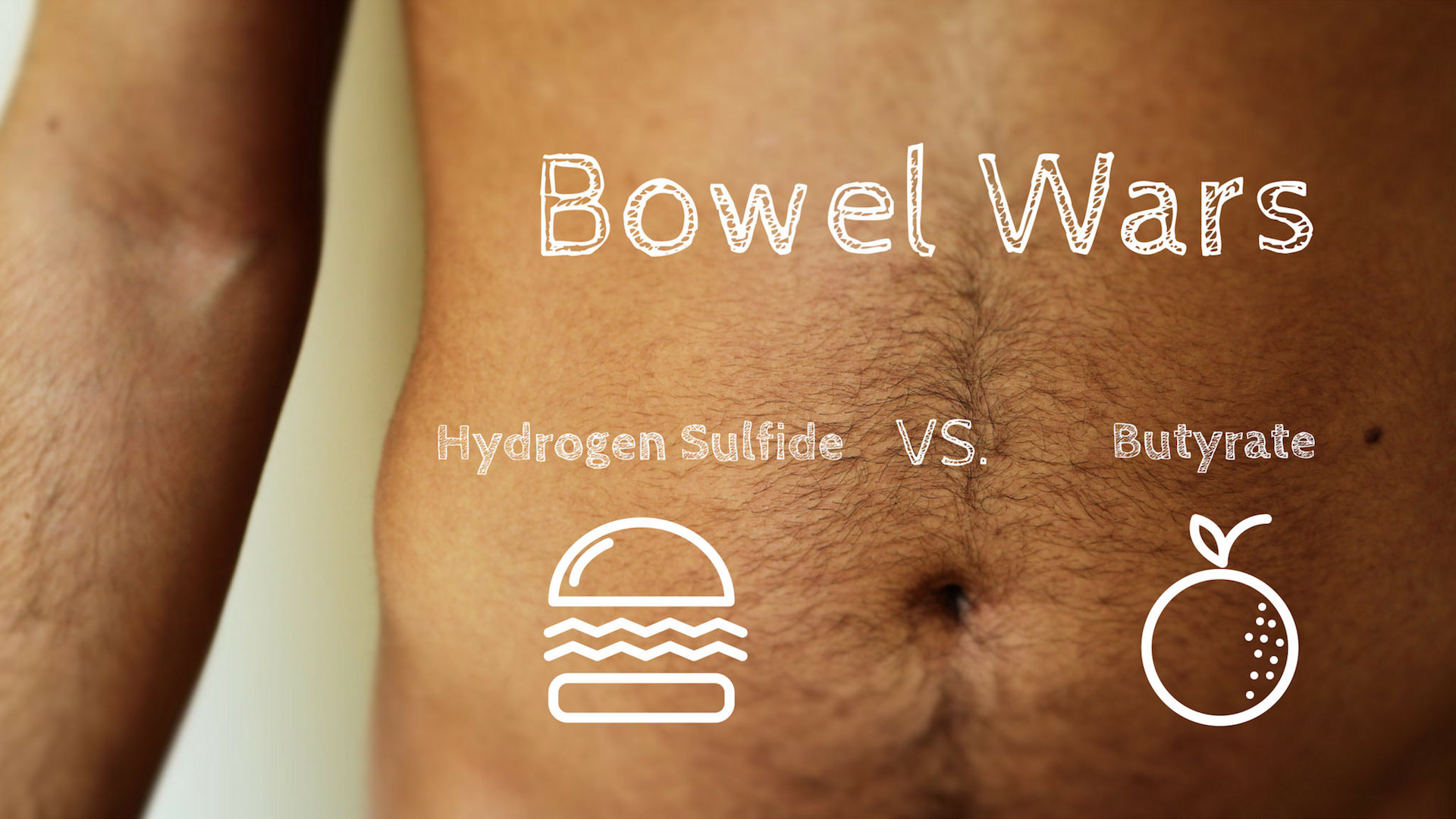There’s a take-off of the industry slogan, “Beef: It’s What’s For Dinner” – “Beef: It’s What’s Rotting in Your Colon.” I saw this on a shirt once with some friends and I was such the party pooper—no pun intended—explaining to everyone that meat is fully digested in the small intestine, and never makes it down into the colon. It’s no fun hanging out with biology geeks.
But I was wrong!
It’s been estimated that with a typical Western diet, up to 12 grams of protein can escape digestion, and when it reaches the colon, it can be turned into toxic substances like ammonia. This degradation of undigested protein in the colon is called putrefaction; so, a little meat can actually end up putrefying in our colon. The problem is that some of the by-products of this putrefaction process can be toxic.
It’s generally accepted that carbohydrate fermentation—the fiber and resistant starches that reach our colon—results in beneficial effects because of the generation of short-chain fatty acids like butyrate, whereas protein fermentation is considered detrimental. Protein fermentation mainly occurs in the lower end of colon and results in the production of potentially toxic metabolites. That may be why colorectal cancer and ulcerative colitis tend to happen lower down—because that’s where the protein is putrefying.
Probably the simplest strategy to reduce the potential harm of protein fermentation is to reduce dietary protein intake. But the accumulation of these toxic by-products of protein metabolism may be attenuated by the fermentation of undigested plant matter. In my video, Bowel Wars: Hydrogen Sulfide vs. Butyrate, you can see that a study out of Australia showed that if you give people foods containing resistant starch, you can block the accumulation of potentially harmful by-products of protein metabolism. Resistant starch is resistant to small intestine digestion; and so, it makes it down to our colon where it can feed our good bacteria. Resistant starch is found in cooked beans, split peas, chickpeas, lentils, raw oatmeal, and cooled cooked pasta (like macaroni salad). Apparently, the more starch that ends up in the colon, the less ammonia that is produced.
Of course, there’s protein in plants too. The difference is that animal proteins tend to have more sulfur-containing amino acids like methionine, which can be turned into hydrogen sulfide in our colon. Hydrogen sulfide is the rotten egg gas that may play a role in the development of the inflammatory bowel disease, ulcerative colitis (see Preventing Ulcerative Colitis with Diet).
The toxic effects of hydrogen sulfide appear to be a result of blocking the ability of the cells lining our colon from utilizing butyrate, which is what our good bacteria make from the fiber and resistant starch we eat. It’s like this constant battle in our colon between the bad metabolites of protein, hydrogen sulfide, and the good metabolites of carbohydrates, butyrate. Using human colon samples, researchers were able to show that the adverse effects of sulfide could be reversed by butyrate. So, we can either cut down on meat, eat more plants, or both.
There are two ways hydrogen sulfide can be produced, though. It’s mainly present in our large intestine as a result of the breakdown of sulfur-containing proteins, but the rotten egg gas can also be generated from inorganic sulfur preservatives like sulfites and sulfur dioxide.
Sulfur dioxide is used as a preservative in dried fruit, and sulfites are added to wines. We can avoid sulfur additives by reading labels or by just choosing organic, since they’re forbidden from organic fruits and beverages by law.
More than 35 years ago, studies started implicating sulfur dioxide preservatives in the exacerbation of asthma. This so-called “sulfite-sensitivity” seems to affect only about 1 in 2,000 people; so, I recommended those with asthma avoid it, but otherwise I considered the preservative harmless. I am now not so sure, and advise people to avoid it when possible.
Cabbage family vegetables naturally have some sulfur compounds, but thankfully, after following more than a hundred thousand women for over 25 years, researchers concluded cruciferous vegetables were not associated with elevated colitis risk.
Because of animal protein and processed food intake, the standard American diet may contain five or six times more sulfur than a diet centered around unprocessed plant foods. This may help explain the rarity of inflammatory bowel disease among those eating traditional whole food, plant-based diets.
How could companies just add things like sulfur dioxide to foods without adequate safety testing? See Who Determines if Food Additives are Safe? For other additives that may be a problem, see Titanium Dioxide & Inflammatory Bowel Disease and Is Carrageenan Safe?
More on this epic fermentation battle in our gut in Stool pH and Colon Cancer.
Does the sulfur-containing amino acid methionine sound familiar? You may remember it from such hits as Starving Cancer with Methionine Restriction and Methionine Restriction as a Life Extension Strategy.
These short-chain fatty acids released by our good bacteria when we eat fiber and resistant starches are what may be behind the second meal effect: Beans and the Second Meal Effect.
I mentioned ulcerative colitis. What about the other inflammatory bowel disease, Crohn’s? See Preventing Crohn’s Disease With Diet and Dietary Treatment of Crohn’s Disease.
In health,
Michael Greger, M.D.
PS: If you haven’t yet, you can subscribe to my free videos here and watch my live, year-in-review presentations:
- 2012: Uprooting the Leading Causes of Death
- 2013: More Than an Apple a Day
- 2014: From Table to Able: Combating Disabling Diseases with Food
- 2015: Food as Medicine: Preventing and Treating the Most Dreaded Diseases with Diet
- 2016: How Not To Die: The Role of Diet in Preventing, Arresting, and Reversing Our Top 15 Killers
